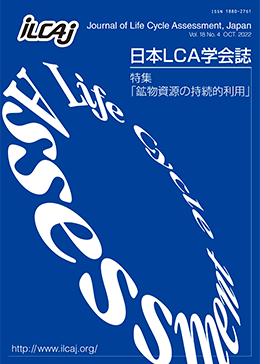Volume 18, Issue 4
Displaying 1-15 of 15 articles from this issue
- |<
- <
- 1
- >
- >|
Contents
-
2022 Volume 18 Issue 4 Pages Toc_1-Toc_4
Published: 2022
Released on J-STAGE: October 27, 2022
Download PDF (939K)
Foreword
-
2022 Volume 18 Issue 4 Pages 179
Published: 2022
Released on J-STAGE: October 27, 2022
Download PDF (803K)
Special Issue: Sustainable Use of Mineral Resources
Commentary and Discussion
-
2022 Volume 18 Issue 4 Pages 180-185
Published: 2022
Released on J-STAGE: October 27, 2022
Download PDF (959K) -
2022 Volume 18 Issue 4 Pages 186-190
Published: 2022
Released on J-STAGE: October 27, 2022
Download PDF (1468K) -
2022 Volume 18 Issue 4 Pages 191-204
Published: 2022
Released on J-STAGE: October 27, 2022
Download PDF (1731K) -
2022 Volume 18 Issue 4 Pages 205-212
Published: 2022
Released on J-STAGE: October 27, 2022
Download PDF (1049K) -
2022 Volume 18 Issue 4 Pages 213-219
Published: 2022
Released on J-STAGE: October 27, 2022
Download PDF (2008K) -
2022 Volume 18 Issue 4 Pages 220-229
Published: 2022
Released on J-STAGE: October 27, 2022
Download PDF (1847K)
General Articles
Research Article
-
2022 Volume 18 Issue 4 Pages 230-239
Published: 2022
Released on J-STAGE: October 27, 2022
Download PDF (1769K)
Report
-
2022 Volume 18 Issue 4 Pages 240-242
Published: 2022
Released on J-STAGE: October 27, 2022
Download PDF (864K)
Introduction of Research Group
-
2022 Volume 18 Issue 4 Pages 243-245
Published: 2022
Released on J-STAGE: October 27, 2022
Download PDF (1126K)
Introduction of Research Group
-
2022 Volume 18 Issue 4 Pages 246-250
Published: 2022
Released on J-STAGE: October 27, 2022
Download PDF (2469K)
Supporting Members
-
2022 Volume 18 Issue 4 Pages 251
Published: 2022
Released on J-STAGE: October 27, 2022
Download PDF (671K)
Index in 2022, All about ILCAJ
-
2022 Volume 18 Issue 4 Pages 252-257
Published: 2022
Released on J-STAGE: October 27, 2022
Download PDF (864K)
Announcement
-
2022 Volume 18 Issue 4 Pages i-iv
Published: 2022
Released on J-STAGE: October 27, 2022
Download PDF (938K)
- |<
- <
- 1
- >
- >|
